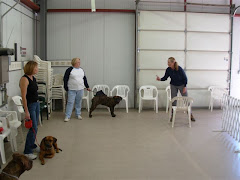 It hit me like a ton of bricks at agility class this week. Sadie is the "special needs" dog I worked with last Saturday (read the post from Oct. 23). Her owner had kidded that she was "stubborn," and I deduced while working with her that she had an extremely high will to please but was afraid of failure. My general observations (that she thrived on extreme calmness and routine) were reinforced in class this week; Sadie fell in love with the dogwalk after I painstakingly coaxed her across it several times. But the real eye-opener was Sadie's reaction to the weave poles!
It hit me like a ton of bricks at agility class this week. Sadie is the "special needs" dog I worked with last Saturday (read the post from Oct. 23). Her owner had kidded that she was "stubborn," and I deduced while working with her that she had an extremely high will to please but was afraid of failure. My general observations (that she thrived on extreme calmness and routine) were reinforced in class this week; Sadie fell in love with the dogwalk after I painstakingly coaxed her across it several times. But the real eye-opener was Sadie's reaction to the weave poles!For those who don't know about weave poles...this is the most challenging of all agility obstacles for beginners. Six PVC poles are placed 24 inches apart in a straight line on a metal track. The dog must learn to rapidly weave his body in and out of the six poles. At the arena, and here at home, we have sets of "channel weaves" that make the learning simpler for new dogs. Last Saturday I tried Sadie on the channel weaves in our back yard, and to my utter amazement she picked up the routine immediately and without balking. Within minutes she was doing advanced work that takes most dogs weeks to accomplish. Best of all, she was totally on task while doing it; she was calm, focused, comfortable, and driven. Mind you, this was the same dog that screamed and refused jumps when I would mix up the pattern I wanted her to run.
When Sadie demonstrated more utterly jaw-dropping weave pole finesse at class this week, it all made sense. Sadie is one of those 3 to 6 dogs out of 1,000 who have autism.
Autism in dogs? You bet. I'm a believer. Dogs are susceptible to the same types of conditions, mental and physical, as humans, and, from my observation, at about the same proportion. The 3-6 out of 1,000 is actually a human statistic, but it seems appropriate to me. Autism is difficult enough to diagnose, explain, understand and treat in humans. It is a spectrum disorder; the symptoms can occur in any combination, and with varying degrees of severity. The same must be true with animals, and can be more easily identified in dogs because they live with us as family members.
The symptoms may include:
- Lack of direct eye contact
- Stiffening when touched in various parts of their body (except for face and head)
- Irrational fear of new situations
- Strong negative reaction to things that seem "out of place."
- Inability to accept proper social cues from peers (dogs)
Call me far out, but I see Sadie whipping through those weave poles as calmly as if she were in a squeeze machine. Weaving through the PVC poles offers her everything she craves...routine, consistency, repetition, and a feeling of solid but yielding objects against her body. They calm her for the whole three seconds she's doing them.
I've long believed our last Swissy, Kosmo, was autistic. We had owned five, and Kosmo was definitely not on the same sheet of music as the others. He related to world, and even to his own body, in a different way. He displayed many of autism's characteristics. He wasn't stupid, nor was he obsessive-compulsive; he was simply wired differently from .97% of the dog population.
There's no "cure" for autism, but there is management. Sticking with routines is of extreme importance. Patient, repetitive training exercises can pay big dividends. Keeping the dog leashed in strange or open areas is critical for safety. Most crucial of all is accepting the dog's unique point of view on his surroundings and himself, and helping him achieve his potential within those parameters. He's not "less." He's just "different."
 |
| This is actually my Lizzie who is definitely NOT autistic...but it kind of looks like Sadie doing weave poles, and it's a cool picture. By Les Korcala, dogactionfotos.com. |


















1 comment:
That's so interesting, Jan! I never thought about autism in dogs!!
Post a Comment